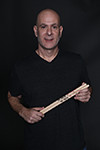The Art of the Drum Solo: Playing “Lead” Drums
The Art of the Drum Solo: Playing “Lead” Drums
by Dave Stark
February 10, 2020
Drum solos. I’ve met drummers who hate them and others who play the whole gig waiting for that moment where they can show the world just what they’re made of. Solos come in all shapes, sizes, lengths, and forms. The one constant I’ve found in my experience is that many drummers have never really been taught how to compose a drum solo. Most simply throw together an assortment of their very best licks and fills. Often there’s little, if any, connection between the solo and the tune or between one lick and another. While these solos might impress some audiences and demonstrate some significant chops, they are far more technical than musical.
When I was younger, I played in my junior high school jazz band as well as in a rock band with friends, working on some pretty technically advanced music for little kids. When I was asked to “trade-4’s” for the first time, however, I had no idea what to do. How was I supposed to keep track of four measures while playing every lick I could at the fastest tempo possible? To me, that’s what a drum solo was. I didn’t think in terms of how many measures I was playing; I was just stringing ideas together. Either I had to just play my best and guess where the four bars ended or I had to count the measures carefully and watch my playing suffer. No matter what, I was stuck in a situation where in order to solo, I was going to have to give up something.
At this point I decided to change my thinking from playing a solo to taking a “lead.” Leads like a lead guitarist? Yes, that’s exactly how I approached it. When it was time for guitarists, keyboard players, saxophonists, etc., to take their leads or solos, they played over the form of the tune. So that’s what I was going to do!
To practice, I would turn on a song and groove for a bit to get the feel. Then I would gradually build a “lead” drum part over the entire tune. I’d start simply by leaving space, then I would slowly build my solo ideas over the verse, chorus, bridge, and eventually the entire song. In this way, I could incorporate dynamics, phrasing, pacing, rhythmic motives, etc., and really get a chance to see how the different things I’d learned fit together in a musical context within a song.
After this process was complete, I started practicing solos in sections. I’d play a solo just over the verse or chorus. By playing within that song structure, I could easily “feel” where 4, 8, or 16 bars were. Soon enough, I was able to take solos over an entire tune or any specific part of it because I was now thinking of the song as I played. I could hear it, and even sing it to myself if needed, and I could play my “lead” part with respect for the tune, rather than being oblivious of it.
I started having other drummers tell me that they loved my “phrasing.” By taking this approach to soloing in a section of a tune, over a vamp, over the entire tune, or just setting up a solo at a clinic, I could play enough of a groove that everybody could always follow my musical journey. My phrases fit together because I was always playing the tune and constantly knew exactly where I was.
When you need to work on soloing and also want to work on your general phrasing (which is highly important in its own right), I highly suggest you set aside time to work on playing “lead drums.” Approach songs and playing over parts the same exact way a guitarist or saxophonist might. It doesn’t need to be complicated; it simply needs to flow with the tune that you are playing your “lead” over. You’ll forever know just where you are within your solos, and the people on stage and off will always follow you on your journey because you are able to communicate to them the same thing you’re hearing and feeling internally!

Dave Stark is a professional musician, educator, and clinician who has been teaching for over 30 years. He’s a member of the PAS Education Committee, and previously served on the PAS Drum Set Committee.









